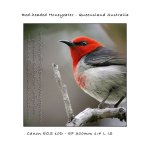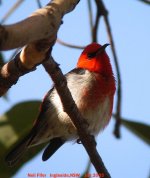foto_wombat
Member
Hi all,
Just had a visit from this delightful little guy. Was gone before I had a chance to get any decent photos and this "grab shot" was all I got.
I think this is the north coast Cape York subspecies of the Red-headed Honeyeater, Myzomela infuscata - can anyone confirm?
I photographed him on the Atherton Tablelands, south of Cape York, Australia and I think he'd be at the edge of his range.
Absolutely beautiful, small and agile - I hope I see him again.
kind regards
Peter
www.peter-brown-photographer.com
www.wilderness-images-gallery.com
Just had a visit from this delightful little guy. Was gone before I had a chance to get any decent photos and this "grab shot" was all I got.
I think this is the north coast Cape York subspecies of the Red-headed Honeyeater, Myzomela infuscata - can anyone confirm?
I photographed him on the Atherton Tablelands, south of Cape York, Australia and I think he'd be at the edge of his range.
Absolutely beautiful, small and agile - I hope I see him again.
kind regards
Peter
www.peter-brown-photographer.com
www.wilderness-images-gallery.com






